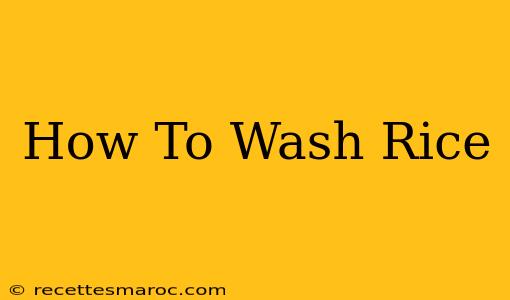Washing rice might seem like a simple task, but doing it properly can significantly impact the taste and texture of your final dish. Improperly washed rice can result in a gummy, sticky mess, while properly washed rice cooks up light, fluffy, and delicious. This comprehensive guide will walk you through the best techniques for washing rice, no matter what type you're using.
Why Wash Rice?
Before we dive into the how-to, let's understand the why. Washing rice serves several crucial purposes:
- Removes Excess Starch: Rice grains are coated in starch. Excess starch can lead to a sticky, clumpy texture when cooked. Washing removes much of this starch, resulting in separate, fluffy grains.
- Rinses Away Impurities: Rice can contain dust, debris, or small stones from the harvesting and processing process. Washing helps to remove these impurities, ensuring a cleaner, more palatable meal.
- Improves Flavor: Removing excess starch allows the rice's natural flavor to shine through, enhancing the overall taste of your dish.
- Better Texture: As mentioned, washing contributes to a lighter, fluffier texture, preventing that undesirable gummy consistency.
How to Wash Rice: A Step-by-Step Guide
The method for washing rice is surprisingly straightforward. Here's a step-by-step guide you can follow, regardless of whether you're using long-grain, short-grain, or other varieties:
1. Measure and Rinse: Start by measuring the desired amount of rice into a fine-mesh sieve or a large bowl. Place the rice under cold, running water. Gently swirl the rice with your hand to loosen any loose debris.
2. Rub and Agitate: Gently rub the rice grains between your fingers or palms. This helps to further remove the excess starch. Continue agitating the rice under the running water. You'll notice the water turning cloudy as the starch is released.
3. Repeat the Process: Repeat steps 1 and 2 several times until the water runs relatively clear. The number of times you need to rinse will depend on the type of rice and its initial starch content. Usually, 3-5 rinses are sufficient.
4. Drain Thoroughly: Once the water runs clear, allow the rice to drain completely in the sieve or bowl. This ensures excess water doesn't interfere with the cooking process.
Different Types of Rice: Considerations for Washing
While the basic washing technique remains consistent, some rice varieties might require slight adjustments:
- Long-grain rice: This type generally requires fewer rinses as it has a lower starch content.
- Short-grain rice (like sushi rice): This type tends to have a higher starch content and might require more rinses to achieve the desired fluffiness.
- Brown rice: Brown rice has a bran layer that contains nutrients and fiber. Wash brown rice gently to avoid removing too much of these beneficial elements.
Tips for Perfectly Washed Rice
- Use Cold Water: Cold water helps to better separate the starch from the rice grains.
- Don't Overwash: Overwashing can remove essential nutrients. Aim for clear water, but don't rinse excessively.
- Proper Cooking: Even with perfectly washed rice, incorrect cooking techniques can affect the outcome. Make sure to follow the cooking instructions for your specific rice variety.
Conclusion: Mastering the Art of Rice Washing
Washing rice is a fundamental yet often overlooked step in preparing delicious and flavorful meals. By following these simple steps and paying attention to the nuances of different rice types, you can elevate your rice dishes to a whole new level. So, next time you cook rice, remember the power of a good rinse!

